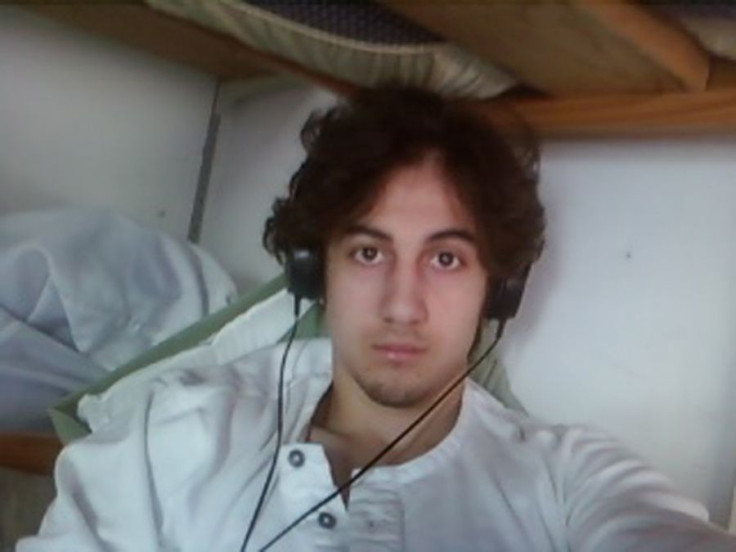Boston Marathon Bombing Trial: Will Dzhokhar Tsarnaev's Age Influence Jurors' Death Penalty Decision?

A young man sat in a courtroom, listening as his lawyers described him as just a boy. He, along with his father-figure mentor, had been caught terrorizing the United States -- killing random people, possibly in the name of Islam. Attorneys argued he was immature, impressionable and didn't truly understand what he was doing: His accomplice had organized the plot -- he had just gone along with it -- and he shouldn't receive the death penalty.
Such was the case for Lee Boyd Malvo, a 17-year-old who was convicted and sentenced to life in prison for his involvement in the 2002 Beltway sniper attacks that killed 10. It's also the strategy defense lawyers have employed in an effort to keep Dzhokhar Tsarnaev alive.
Tsarnaev was found guilty earlier this month on all 30 federal charges stemming from his role in the 2013 Boston Marathon bombings that left four people dead and more than 260 wounded before an ensuing carjacking, another murder and a shootout in a nearby suburb. The penalty phase of his capital murder trial started Tuesday, and the jury must decide whether to sentence the 21-year-old to life in prison or execution. Experts say Tsarnaev's youth, sure to be a central theme in defense testimony, could compel the jury to choose the former.
"One of the things that should influence their idea of culpability is his age," said Valerie Hans, a jury scholar and professor at Cornell University Law School in Ithaca, New York. "Age is just really a very significant factor."
In deciding Tsarnaev's punishment, the jury must weigh the aggravating factors the prosecution presents against the mitigating factors the defense presents. The 18 jurors were instructed not to consider the defendant's race, color, sex, national origin or religious beliefs, but his maturity is fair game. Tsarnaev's lawyers have long alleged his domineering older brother, Tamerlan Tsarnaev, coerced him into the Islamist radicalism blamed for the 2013 bombing.
Massachusetts outlawed capital punishment in 1984, but Tsarnaev's case is being tried in federal court. Since 1988, the federal government has executed only three people: Oklahoma City bomber Timothy McVeigh, drug lord Juan Raul Garza and convicted murderer Louis Jones. All were over 30. Through 2011, only about 1 percent of inmates on death row were under age 25.
Tsarnaev was 19 at the time of the bombings, which makes him eligible for execution despite the U.S. Supreme Court's 2005 ruling that juveniles could not receive the death penalty. But the 2005 decision cited research that showed adolescents' brains don't fully develop until their mid-20s -- a fact Tsarnaev's defense will likely bring up to the jury, said Robert Dunham, executive director of the Death Penalty Information Center, a nonprofit in Washington, D.C. "It's not just his chronological age, but it is the various characteristics of adolescents and youth," he added. Young adults are especially susceptible to peer pressure, for example, which could explain how Tsarnaev's brother held so much control over him.
Hans said the jury could also think that because Tsarnaev is still maturing, there's a chance he could be rehabilitated. Tsarnaev, a college student at the University of Massachusetts Dartmouth, didn't have a history of violence. In fact, during the first part of the trial defense lawyers emphasized his laid-back attitude and love for marijuana. Evidence in that vein could indicate to the jury that he won't be a danger to himself or others in prison, Hans said.
If Tsarnaev is sentenced to life in prison without parole, he'll likely go to ADX in Florence, Colorado, known for being the highest-security prison in the U.S. He'll be in solitary confinement for 23 hours a day, according to CBS Boston.
On the opposite end of that spectrum, if he is sentenced to death, he'll likely be sent to the U.S. Penitentiary in Terre Haute, Indiana. There are 61 people there on the federal death row, according to Dunham's center. Many of them are waiting out appeals -- exactly what the family of 8-year-old Boston Marathon bombing victim Martin Richard said they feared would happen with Tsarnaev's case. In an editorial published last week in the Boston Globe, Bill and Denise Richard requested that prosecutors take the death penalty off the table "to end the anguish."
Louis Jones, a murderer who was the last person executed by the federal government, was convicted in 1995 and died in 2003. It costs states up to about $90,000 annually to house a death row prisoner.
The jurors in the Tsarnaev trial were instructed not to consider what victims and their families want. Nor should they be concerned with how much it costs to keep a prisoner in custody for life, Dunham said. Instead, "the issue in front of a jury is whether, based on aggravating and mitigating circumstances, they believe that Tsarnaev should live or be sentenced to die."
That decision-making process can be subconsciously influenced by geography and race. The Northeast, where Tsarnaev's trial is, is less likely to execute criminals than the South. That could translate into jurors who tend to favor life in prison. But ethnicity could also influence their verdict, as about 44 percent of people on death row in 2012 were minorities. Tsarnaev was born in the former Soviet republic of Kyrgyzstan, and his family is ethnically Chechen.
Ultimately, the jury's sentence for Tsarnaev is hard to predict, said Robert Bloom, a law professor at Boston College. The diversity of the jury system ensures that, and it's even more difficult because the decision on the death penalty must be unanimous.
"All it's going to take is one juror to vote for life," Bloom said. "Will it influence one juror the fact that he was a 19-year-old, failing in college, smoking a lot of marijuana, floating through life? Could that affect the decision of one juror? Draw your own conclusions."
© Copyright IBTimes 2024. All rights reserved.






















